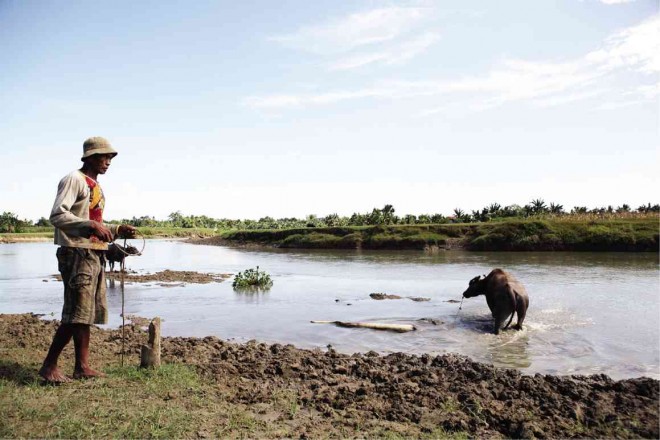
A FARMER sends his carabao to graze on the site of a gun battle between Moro guerrillas and Special Action Force commandos in Mamasapano town, Maguindanao province, where 44 commandos died, many after making their last mobile phone calls to their families. JEOFFREY MAITEM/INQUIRER MINDANAO
As special Action Force commandos of the Philippine National Police exchanged fire with Moro rebels in a marshy village in Maguindanao province, the military did not provide artillery support, SAF commanders said on Monday.
But the military top brass justified its decision, asserting that an attack on the Moro Islamic Liberation Front (MILF) would have escalated into a war to the detriment of the peace process.
“Had the artillery support arrived hours earlier, the number of casualties would have been less,” Director Getulio Napeñas, relieved SAF commander, told the Senate committees on public order, peace and finance.
Hours into the fighting in Mamasapano town on Jan. 25, the then SAF deputy commander, Chief Supt. Noli Taliño, went to the 1st Mechanized Brigade in Shariff Aguak, also in Maguindanao, to request reinforcements.
Request for artillery
Taliño broached the idea of artillery support with Col. Gener del Rosario but Maj. Gen. Edmundo Pangilinan, commander of the 6th Infantry Division, rejected this.
“I want to give you that but the division commander doesn’t want to because of the peace process,” Taliño, the now acting SAF chief, quoted Del Rosario as saying.
Del Rosario, however, organized six armored vehicles to link up with the SAF advance command post, Taliño said.
The Senate opened its inquiry into the debacle where 44 SAF commandos were killed when they ran into MILF rebels and Bangsamoro Islamic Freedom Fighters after taking down Jemaah Islamiyah terrorist Zulkifli bin Hir, alias “Marwan.”
The SAF commanders did not inform the military, PNP officer in charge Deputy Director General Leonardo Espina and Interior Secretary Mar Roxas until after the mission had been launched.
Risk of leakage
Informing the military entailed the risk of leakage to MILF contacts within the military camps, SAF commanders said.
The Armed Forces of the Philippines Chief of Staff, Gen. Gregorio Pio Catapang, said the military was informed of the mission during the actual operation.
Catapang said that before clearance for artillery fire could be given, three things needed to be clarified: The location of the enemy, the location of the friendly troops and the presence of a “forward observer.”
Through the forward observer, the military would know where the shells would fall, he said.
“Artillery fire could not be given because of the circumstances,” Catapang told the senators.
Besides, the AFP chief of staff said, the order to the military was “to extricate the beleaguered forces, but not to engage the MILF.”
Peace process
“Inasmuch as we have a peace process, we don’t want to endanger these things,” Catapang said. “If we attacked the MILF, they might think that we’re back to war. We don’t want that to happen. Like fire, if it’s not contained, we might have skirmishes not only in Lanao del Sur but in the whole Central Mindanao.”
Congress is racing against time to pass a draft law carving a new, autonomous Bangsamoro region by March in keeping with the administration’s timeline of getting new Bangsamoro officials elected in May 2016.
Napeñas said that on the morning of the firefight, while en route to the 1st Mechanized Brigade to ask for reinforcement, he sent a text message to both Taliño and Espina, detailing the coordinates of the firefight as well as the position of the SAF forces and the rebels.
He got a reply from Taliño: “Sir, as of now, they can’t give us artillery support because there could be civilians and children in the area.”
Air support ruled out
Catapang also ruled out air support for the SAF commandos who came under heavy fire from the Moro guerrillas following Marwan’s neutralization.
“We can’t do that. First of all, there was no request for air support. If we did provide, it would inflame the situation. The important thing was to set up a ceasefire mechanism at that point in time,” he said.
MILF fired upon first
Rasid Ladiasan, chair of the MILF coordinating committee on the cessation of hostilities, said he relayed a request for ceasefire to the MILF military unit, but this was rejected.
“They claimed they were fired upon first. Two were wounded and one was killed,” he told the committees. “It was difficult because of the close encounter.”
The MILF leadership sent Ladiasan to speak on its behalf.
Part of Moro culture
Ladiasan’s counterpart in the government, Brig. Gen. Carlito Galvez Jr., said the dynamics on the ground weren’t that easy as they seemed.
“If there is a fierce gun battle, it’s not easy to separate them. If there are heavy casualties, it’s part of the culture of the Muslims not to leave their dead behind,” he said. “If there’s an encounter, it’s really bloody.”
RELATED STORIES
Napeñas: Purisima told me not to tell Roxas, Espina of SAF operation
Purisima briefed Aquino on ‘Exodus’–Napeñas
Poe finds Purisima testimony ‘unbelievable’